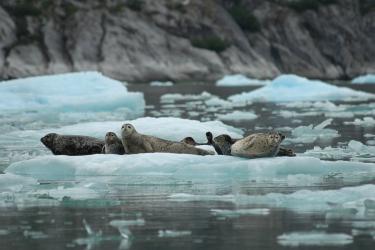The data collected from the eastern Bering Sea (EBS) and northern Bering Sea (NBS) Bottom Trawl Surveys are used for ecosystem monitoring and to help manage commercially important species in Alaska. In addition to species composition, survey vessels collect measurements of ocean characteristics at each survey station, including ocean bottom temperatures. These measurements are used to create regional temperature maps for the Bering Sea and are updated each business day during the survey. The differences between this and past year's temperatures can help us understand how these changes in temperature affect fishes, crabs, and other bottom-dwelling species.
Temperature Collection
Temperature, seawater conductivity (as a proxy for salinity), and depth (as defined by pressure) are collected by Conductivity, Temperature, and Depth (CTD) sensors. The CTD sensors are deployed in the trawl net and collect data every few seconds while underwater.
Temperature Anomalies
Scientists explore the differences between temperatures observed on the survey to temperatures measured in past surveys. These differences are known as temperature anomalies. Temperature anomalies are calculated by subtracting this year’s temperatures at a survey station from the average of all prior years’ temperatures at the same location. These temperature anomalies are a good indicator of local changes. Since the late 1990s, temperature anomalies have become more extreme, both in terms of more exaggerated temperature swings between years and longer sustained warm and cold periods. These extended warm and cold periods are called “warm stanzas” or “cold stanzas,” respectively. This PDF provides static maps of each day's progress.
Cold pool index and temperature time series
The area that the cold pool covers is represented by the cold pool extent index. The cold pool index is used to track the changes in bottom temperatures observed by the bottom trawl survey in a standardized way. This index is defined as the total area of the eastern Bering Sea survey area where bottom temperatures are less than or equal to 2°C, in units of square kilometers (km2).
The size and location of the cold pool changes from year to year. The cold pool extent in 2022 was similar to the long-term average, following record-low extents (warmer temperatures) observed in 2018-2019. Ocean bottom temperatures across the eastern Bering Sea were colder than average from 2006-2013 (“cold stanza”) and warmer than average from 2014-2021 (“warm stanza”).
Rapid changes in average ocean bottom temperatures have resulted in large changes to fish, crabs, and other bottom-dwelling species distributions. The cold pool can act as a boundary separating Arctic species from subarctic species. These subarctic species include commercially important fish like walleye pollock and Pacific cod.
Timing of the Survey
The seasonal timing of the surveys remains roughly constant from year to year, with stations sampled in approximately the same order each year. Stations in the eastern portion of the survey area are sampled earlier in the year than the northwestern stations. This delay means later stations have more time to warm up in the summertime weather. This creates a strong gradient of bottom temperature at the boundary of the NBS and EBS regions. The gradient reflects a difference in seasonality at the time of sampling, rather than a strong spatial temperature gradient at a single point in time.
Data access
This article provides a brief explanation and update on the cold pool index and related temperature products. Learn more about the cold pool and species distributions in Rohan et al. (2022), the 2022 eastern and northern Bering Sea Data Report, and Ecosystem Status Reports for the Gulf of Alaska, Bering Sea and Aleutian Islands (brief).
The temperature and index data used and discussed here can be accessed from the Fisheries One Stop Shop (FOSS) platform and coldpool R package. FOSS publicly provides all final catch and haul data from all Bottom Trawl Surveys conducted by the Groundfish Assessment Program.









